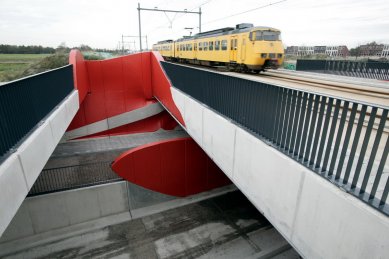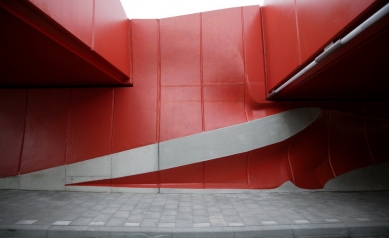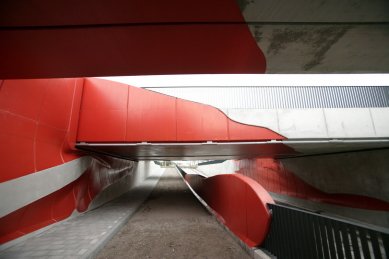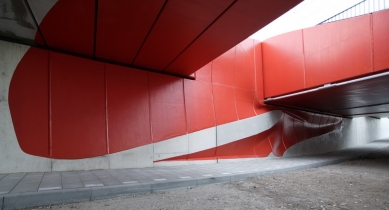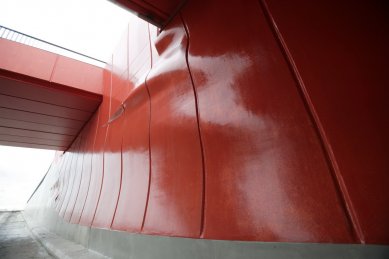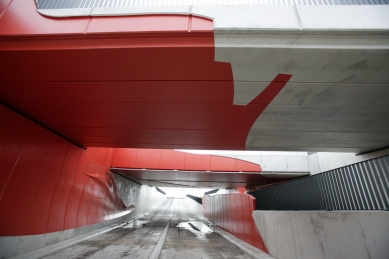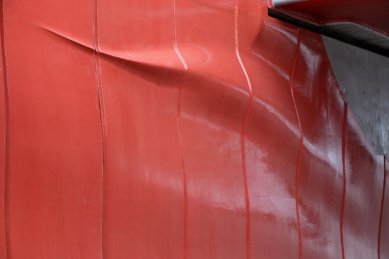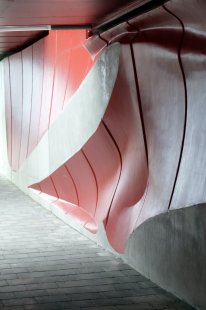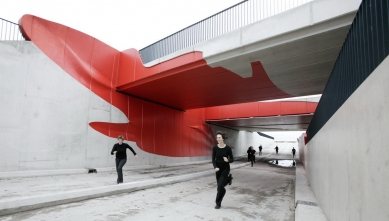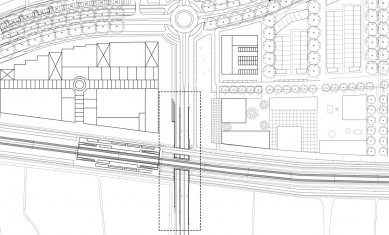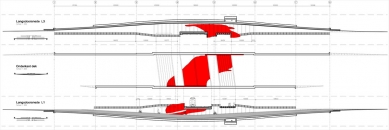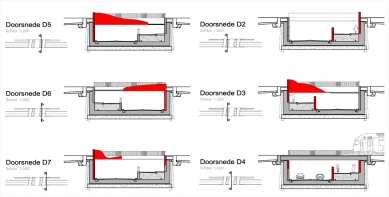
Touch of Evil
tunnel Pijnacker

team: Joan Almekinders, Samir Bantal, Hans Larsen, Enrique Moya-Angeler, Maurice Nio, Arek Seredyn, Tine Silvester-Iversen
How many bridges have you passed under? How many did you stop under? How many of them captured your attention enough that you remembered them? This bridge is not in an exceptional location. It is not remarkable for its size, price, or sophisticated construction. It is not extraordinarily record-breaking in any tabulated value. It is quite an ordinary bridge, yet I believe that even if you rushed under this bridge without stopping, you would surely remember it... There is certainly something exceptional about it. Perhaps it is not even the bridge itself that is remarkable, but the place...
Nio Architecten's projects are named after films. This bridge bears the name of a film by Orson Welles from 1958 - Touch of Evil. It is an apt title, even though it subtly invites bloody interpretations. The assignment itself is generally somewhat atypical, yet typical for Nio Architecten. The engineering design of a standard piece of infrastructure - in this case, a bridge - was de facto finished. The architects could only realize themselves "superficially." They could work only with the surface up to a maximum depth of 30 centimeters, focusing on the design of railings, lighting, and other details. Using specially milled formwork, a bas-relief was created, painted over the entire surface, objectively speaking, red. The special "Mika" paint technology was supposed to allow the surface to change color from red to orange depending on the angle of light. In reality, however, red significantly outperformed the national orange.
Is it even architecture? How much architecture can fit into a 30-centimeter layer on the surface? Is it significant? Maurice Nio's team attempts to break free from the shackles of the so-called "architectural approach." The goal is to approach each project anew and to prevent boredom through repetition. This project was an interesting experiment. The effort was to create a design that escapes human understanding. A transcendent design that could never be created by a human. A design from far outside the earth. The resulting shape could be a trace, an imprint left here by something extraterrestrial, moving according to incomprehensible algorithms within the space of the bridge. A human is merely an observer.
In his book Unseen I Slipped Away (optional required reading for the office), Maurice Nio writes about his approach to designing. He writes about unique and independent things that differ from ordinary things. Unique things contain invisible "watermarks" that make them unrepeatable, irreplaceable, and incapable of being copied. With exaggeration, he gives the example of 37 security features hidden in each euro banknote. He writes about independence, the sovereignty of things that can be unique anywhere, under any conditions.
Just like Venturi, he postmodernly considers unique things to be those that are not completely rational and unambiguous, things that are clear yet hazy, multi-meaning things. Mystical things that carry certain secrets.
Does this bridge hide any secrets? Does it tell the whole story to the end, or does it, like Ray Bradbury, leave the story open and give space to your imagination to conclude it? How will it end today? Will it end the same way when you read the same story again in a few years? Each person must answer for themselves. Thus, at least the answer will be unique.
Note: 10 percent of the costs (€3,600,000) includes architectural elements
How many bridges have you passed under? How many did you stop under? How many of them captured your attention enough that you remembered them? This bridge is not in an exceptional location. It is not remarkable for its size, price, or sophisticated construction. It is not extraordinarily record-breaking in any tabulated value. It is quite an ordinary bridge, yet I believe that even if you rushed under this bridge without stopping, you would surely remember it... There is certainly something exceptional about it. Perhaps it is not even the bridge itself that is remarkable, but the place...
Nio Architecten's projects are named after films. This bridge bears the name of a film by Orson Welles from 1958 - Touch of Evil. It is an apt title, even though it subtly invites bloody interpretations. The assignment itself is generally somewhat atypical, yet typical for Nio Architecten. The engineering design of a standard piece of infrastructure - in this case, a bridge - was de facto finished. The architects could only realize themselves "superficially." They could work only with the surface up to a maximum depth of 30 centimeters, focusing on the design of railings, lighting, and other details. Using specially milled formwork, a bas-relief was created, painted over the entire surface, objectively speaking, red. The special "Mika" paint technology was supposed to allow the surface to change color from red to orange depending on the angle of light. In reality, however, red significantly outperformed the national orange.
author's report
Is it even architecture? How much architecture can fit into a 30-centimeter layer on the surface? Is it significant? Maurice Nio's team attempts to break free from the shackles of the so-called "architectural approach." The goal is to approach each project anew and to prevent boredom through repetition. This project was an interesting experiment. The effort was to create a design that escapes human understanding. A transcendent design that could never be created by a human. A design from far outside the earth. The resulting shape could be a trace, an imprint left here by something extraterrestrial, moving according to incomprehensible algorithms within the space of the bridge. A human is merely an observer.
In his book Unseen I Slipped Away (optional required reading for the office), Maurice Nio writes about his approach to designing. He writes about unique and independent things that differ from ordinary things. Unique things contain invisible "watermarks" that make them unrepeatable, irreplaceable, and incapable of being copied. With exaggeration, he gives the example of 37 security features hidden in each euro banknote. He writes about independence, the sovereignty of things that can be unique anywhere, under any conditions.
Just like Venturi, he postmodernly considers unique things to be those that are not completely rational and unambiguous, things that are clear yet hazy, multi-meaning things. Mystical things that carry certain secrets.
Does this bridge hide any secrets? Does it tell the whole story to the end, or does it, like Ray Bradbury, leave the story open and give space to your imagination to conclude it? How will it end today? Will it end the same way when you read the same story again in a few years? Each person must answer for themselves. Thus, at least the answer will be unique.
Note: 10 percent of the costs (€3,600,000) includes architectural elements
Radek Brunecký
The English translation is powered by AI tool. Switch to Czech to view the original text source.
0 comments
add comment



